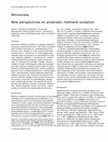Papers by William Reeburgh
Oceanographic conditions during 1973 in Russell Fjord, Alaska
Estuarine and Coastal Marine Science, 1976
Control of Tundra Methane Emission by Microbial Oxidation
Ecological Studies, 1996
Methane oxidation in the eastern tropical North Pacific Ocean water column
Journal of Geophysical Research: Biogeosciences, 2015
Marine sediments comprise a large methane reservoir (~10^19 g carbon), yet little of this potent ... more Marine sediments comprise a large methane reservoir (~10^19 g carbon), yet little of this potent greenhouse gas makes its way to the atmosphere. This is because microbially mediated methane oxidation in the shallow sediments and water column effectively consumes methane and limits the ocean's annual emissions to 2.5% of the total methane flux to the atmosphere. Despite the key role
Depth Distributions of Gases in Shallow Water Sediments
Natural Gases in Marine Sediments, 1974

Rapid methane oxidation in a landfill cover soil
Applied and environmental microbiology, 1990
Methane oxidation rates observed in a topsoil covering a retired landfill are the highest reporte... more Methane oxidation rates observed in a topsoil covering a retired landfill are the highest reported (45 g m day) for any environment. This microbial community had the capacity to rapidly oxidize CH(4) at concentrations ranging from <1 ppm (microliters per liter) (first-order rate constant [k] = -0.54 h) to >10 ppm (k = -2.37 h). The physiological characteristics of a methanotroph isolated from the soil (characteristics determined in aqueous medium) and the natural population, however, were similar to those of other natural populations and cultures: the Q(10) and optimum temperature were 1.9 and 31 degrees C, respectively, the apparent half-saturation constant was 2.5 to 9.3 muM, and 19 to 69% of oxidized CH(4) was assimilated into biomass. The CH(4) oxidation rate of this soil under waterlogged (41% [wt/vol] H(2)O) conditions, 6.1 mg liter day, was near rates reported for lake sediment and much lower than the rate of 116 mg liter day in the same soil under moist (11% H(2)O) con...

Anaerobic methane oxidation is a globally important but poorly understood process. Four lines of ... more Anaerobic methane oxidation is a globally important but poorly understood process. Four lines of evidence have recently improved our understanding of this process. First, studies of recent marine sediments indicate that a consortium of methanogens and sulphate-reducing bacteria are responsible for anaerobic methane oxidation; a mechanism of`reverse methanogenesis' was proposed, based on the principle of interspecies hydrogen transfer. Second, studies of known methanogens under low hydrogen and high methane conditions were unable to induce methane oxidation, indicating that`reverse methanogenesis' is not a widespread process in methanogens. Third, lipid biomarker studies detected isotopically depleted archaeal and bacterial biomarkers from marine methane vents, and indicate that Archaea are the primary consumers of methane. Finally, phylogenetic studies indicate that only specific groups of Archaea and SRB are involved in methane oxidation. This review integrates results from these recent studies to constrain the responsible mechanisms.
Black Sea methane geochemistry
Deep Sea Research Part A. Oceanographic Research Papers, 1991
Methane concentrations and oxidation rates were measured in the water column and sediments of the... more Methane concentrations and oxidation rates were measured in the water column and sediments of the Black Sea at a central station during leg 5 of the 1988 USTurkey Black Sea Expedition. Methane concentrations were 10 nM in the upper 100 m, increased to 11 μM ...
v+ ve+ ve2+ ve3+ ve4+-..=-(1” e)’If e is indeed< lo%, then the value of the whole string of comments, at 1.1, is hardly larger than the value of the original alone
An Estimate of Methane Emission for the Kuparuk River Region
of methane in boreal forest soils
G. Evelyn Hutchinson Medal The recipient of the 1988 Hutchinson Medal of the American Society of Limnology and Oceanography is Trevor Platt, Chief of the Biological Oceanography Division at the Bedford Institute of Oceanography, Dartmouth, Nova Scotia. The award was presented by Dick Barber at th...
Mitt. Geol.-Palaont. Inst. SCOPE/UNEP Sonderband S 367_375 Hamburg. Univ. Hamburg Heft 66'Februar 1988
Diagenetic fractionation of carbon isotopes in particulate and dissolved organic matter in sediments from Skan Bay, Alaska
生態系におけるガス交換: その全体像とケーススタディ
Natural radiocarbon in Black Sea water column methane: a tracer of hydrate-derived methane?
The Shallow Hydrocarbon Migration Work shop was held 22 April 2003, in Santa Barbara, California. More details about the workshop can be found at www. bubbleology. com/USHMworkshop. html
Isotope Studies on Cariaco Basin Methane
ABSTRACT
Oceanographic Data from Russell Fjord, Alaska: Summer 1973
Carbon Isotope Fractionation by Anaerobic Methane Oxidation

Uploads
Papers by William Reeburgh